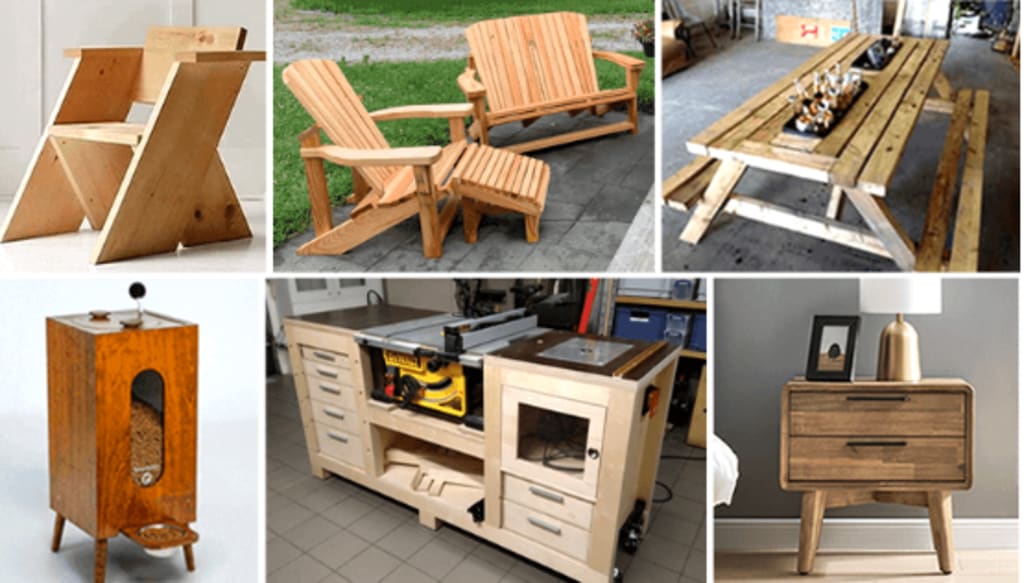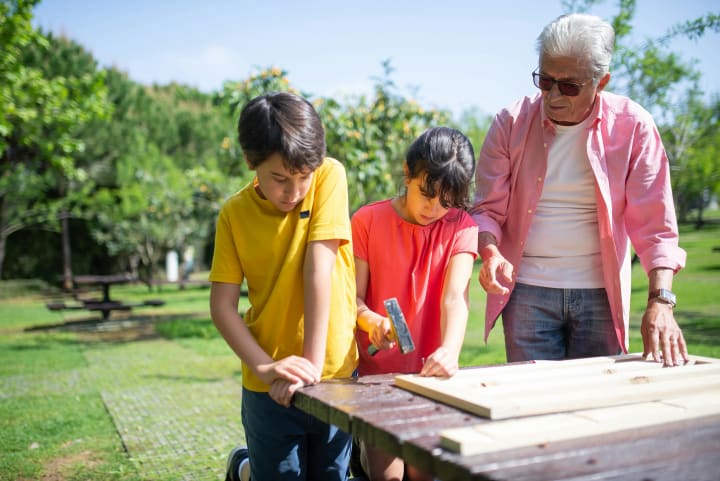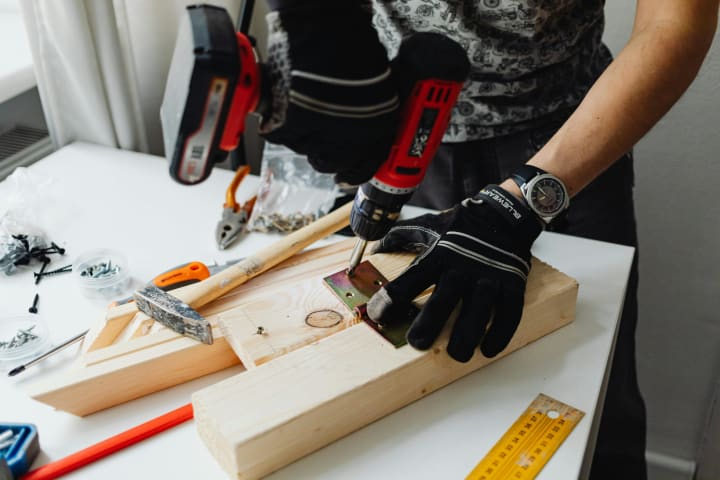From Novice to Maker: Your Guide to Learning Carpentry
How to Start Woodworking

Have you ever dreamt of transforming a rough plank of wood into a beautiful bookshelf, a sturdy table that holds family dinners, or even a whimsical birdhouse for your backyard? Carpentry, the art of working with wood, offers a gateway to this world of creation – a world where you can translate ideas into tangible objects, imbuing them with your own skill and vision. But where do you begin?
This guide is for anyone who feels a spark of interest in learning carpentry. Whether you're a complete novice or someone who's dabbled in a few DIY projects, this journey from wood whisperer-in-waiting to a capable maker is an exciting one.
* Do you dream of crafting beautiful and functional pieces for your home, but lack the plans or inspiration to get started? Look no further than Woodworking website, your one-stop shop for over 16,000 woodworking plans designed for every skill level and project type.
Visit Woodworking website to get started today!

Why Learn Carpentry? More Than Just Building Things
Carpentry isn't just about hammering nails and sawing boards. It's a practice steeped in history, a form of creative expression, and a skill set that offers a multitude of benefits:
1. The Satisfaction of Creation: Imagine the pride of using your own hands to craft a piece of furniture that not only looks stunning but also fulfills a specific need.
2. Boost in Confidence: Every successful project builds your confidence, empowering you to tackle new challenges and experiment further.
3. Stress Relief: The rhythmic nature of woodworking can be incredibly therapeutic, offering a welcome escape from the digital world.
4. Saving Money on Furniture: Learning carpentry allows you to build your own furniture, potentially saving you a significant amount of money compared to buying pre-made pieces.
5. Developing Problem-Solving Skills: Carpentry projects often require creative solutions to unexpected problems. This hones your problem-solving skills, applicable in all areas of life.
6. Building Heirlooms: The pieces you create can become cherished family heirlooms, passed down through generations.
These are just a few reasons why learning carpentry can be such a rewarding experience.
Unveiling the Toolbox: Essential Skills for Beginners
The carpentry world might seem intimidating at first, but fear not! Here are some fundamental skills you can learn to build a strong foundation:
1. Safety First: Always prioritize safety. Learn proper tool usage, wear appropriate protective gear, and maintain a clean workspace.
2. Mastering the Measurements: Precise measuring is crucial for accurate cuts and a successful project. Invest in a good tape measure, level, and square.
3. Sharpening Your Skills (Literally): A sharp saw and chisel make all the difference in achieving clean cuts and efficient work. Learn proper sharpening techniques.
4. The Art of Cutting: Mastering cutting techniques like ripping, crosscutting, and mitering is essential for building different wood components.
5. Joining Forces: Carpentry relies on joining wood pieces securely. Learn techniques like gluing, doweling, and using different types of fasteners.
6. Finishing Touches: Sanding, staining, and applying a protective finish make your project look polished and extend its lifespan.
These core skills can be practiced through simple projects, gradually building your experience and confidence.
* Here's what sets Woodworking website apart:
Unmatched Selection: Explore a library of over 16,000 woodworking plans, from beginner-friendly projects to intricate masterpieces.
Expert-Crafted: Learn from the skills of Ted McGrath, a renowned woodworker and educator, ensuring the quality and accuracy of each plan.
Bonus Resources: Gain access to valuable software to modify plans and potentially other helpful bonus materials to enhance your woodworking journey.
Supportive Community: Get the guidance you need with dedicated customer support ready to answer your questions.
Stop dreaming and start creating! Visit Woodworking website today!
And:
Browse the extensive collection of plans and find your perfect project.
Download and start building with clear, easy-to-follow instructions.

Learning Paths: Charting Your Carpentry Course
There's no one-size-fits-all approach to learning carpentry. Here are some ways to embark on this exciting journey:
1. Formal Education: Consider enrolling in carpentry classes at a local community college or woodworking school. This provides a structured learning environment with expert guidance.
2. Online Resources: The internet is a treasure trove of carpentry tutorials, project ideas, and online communities.
3. Books and Magazines: Classic carpentry books and woodworking magazines are timeless resources, brimming with detailed instructions and inspiration.
4. Apprenticeship: Consider finding a professional carpenter willing to take you on as an apprentice. This offers practical, hands-on learning in a real-world setting.
5. DIY Projects: Start with small, achievable projects to practice your skills. There are countless beginner-friendly projects available online and in woodworking books.
Learning carpentry can be a solitary pursuit or a social one. Joining a woodworking club or maker space allows you to connect with other enthusiasts, share knowledge, and collaborate on projects.
The Journey of a Thousand Cuts: Embracing the Learning Process
The path to becoming a skilled carpenter is a journey, not a destination. Here are some tips to embrace the learning process and make it enjoyable:
1. Start Small, Dream Big: Begin with beginner-friendly projects and gradually increase complexity as you gain experience. Celebrate your small victories!
2. Embrace Mistakes: Everyone makes mistakes. Learn from them, adjust your approach, and move forward.
3. Find Inspiration: Surround yourself with inspiring projects, whether it's browsing woodworking magazines, visiting local furniture stores, or attending craft fairs.
4. Don't Be Afraid to Experiment: Once you've mastered the basics, don't be afraid to experiment with different techniques, materials, and design ideas.
5. Be Patient: Developing carpentry skills takes time and dedication. Be patient with yourself, enjoy the process, and celebrate your progress.
* Unlock your woodworking potential and transform your vision into reality.
Don't wait! Unleash your creativity and embark on your woodworking adventure with Woodworkingwebsite.
Visit Woodworking website to get started today!
The most important tool in your carpentry shed isn't your hammer or saw – it's your passion. When you approach woodworking with genuine enthusiasm, a thirst for knowledge, and a dash of creativity, it becomes more than just a hobby – it's a gateway to a magical world. This world will transform you from a curious novice into a capable maker, able to breathe life into your unique vision. So, roll up your sleeves, embrace the fragrant chaos of sawdust, and take that first fulfilling step into the wonderful world of carpentry. This adventure awaits you, one perfectly measured cut and creative flourish at a time!
About the Creator
Abderrezak. M
I'm a travel, weight loss, health and beauty writer. I am skilled at creativity. I have experience writing on a variety of topics that can help promote health and well-being. My work has been featured in many publications. Follow me!






Comments
There are no comments for this story
Be the first to respond and start the conversation.